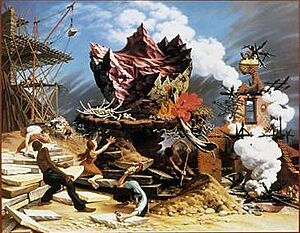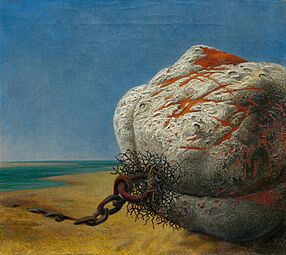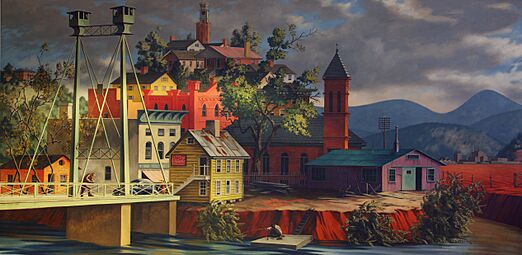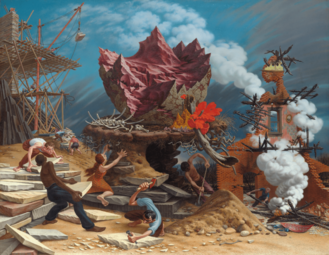Peter Blume facts for kids
Quick facts for kids
Peter Blume
|
|
|---|---|

The Rock, 1944-1948, in the collection of the Art Institute of Chicago
|
|
| Born | October 27, 1906 Smarhoń, Russian Empire
|
| Died | November 30, 1992 (aged 86) |
| Nationality | American |
| Known for | Painting |
| Movement | Folk art, Precisionism, Parisian Purism, Cubism, Surrealism |
Peter Blume (born October 27, 1906 – died November 30, 1992) was an American painter and sculptor. His artwork combined different styles. These included folk art, Precisionism, Parisian Purism, Cubism, and Surrealism.
Contents
Peter Blume's Life Story
Peter Blume was born in Smarhon, a city in the Russian Empire. In 1912, when he was six years old, his family moved to New York City. They made their home in Brooklyn.
Peter loved art and studied it at several schools. These included the Educational Alliance, the Beaux-Arts Institute of Design, and the Art Students League of New York. By 1926, he had his own art studio. He learned from artists like Raphael Soyer and Isaac Soyer. His art was shown by Charles Daniel. The famous Rockefeller family also supported his work.
In 1931, Peter Blume married Grace Douglas. Later in his life, in 1948, he became a member of the National Academy of Design.
Peter Blume's Artworks
Peter Blume really admired the art techniques from the Renaissance period. Before he painted on canvas, he would first draw and make detailed sketches.
Early Recognition and Famous Paintings
In 1932, Peter Blume received a special award called a Guggenheim Fellowship. This allowed him to spend a year traveling in Italy. His first big award came in 1934. He won first prize for his painting South of Scranton at an international art show. This painting was inspired by a road trip he took across Pennsylvania. His old car needed many repairs during the journey.
Another very famous painting is Eternal City (1934–1937). This artwork had a strong political message. It showed Benito Mussolini, who was a leader in Italy at the time, popping out of the Colosseum like a jack-in-the-box. This painting got a lot of attention from art critics and people who saw it. It was inspired by his trip to Italy in 1932. It took Peter Blume five years to finish this important piece. In 1943, when Mussolini was no longer in power, the Museum of Modern Art bought the painting right away.
Peter Blume also worked for a government art program. He painted murals in post offices in Geneva, New York, and Canonsburg, Pennsylvania.
Themes in His Art
Blume's paintings often showed two ideas at once: destruction and rebuilding. He frequently included stones and metal beams in his art. His painting The Rock (1944–1948) is a great example. Many people saw it as a symbol of hope and new beginnings after World War II. This painting is now at the Art Institute of Chicago.
Another painting, Recollection of the Flood (1969), showed people affected by the 1966 Flood of the River Arno in Florence. It also showed people working to restore things after the flood. His painting The Metamorphoses (1979) was inspired by an old Greek story. This story was about Deucalion and Pyrrha, who helped bring life back to Earth after a huge flood.
Gallery
-
The Two Rivers 1943, Federal Building, Post Office & U.S. Courthouse, Rome, Georgia




